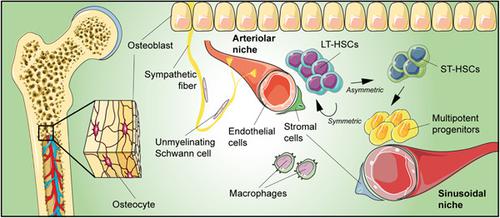当前位置:
X-MOL 学术
›
J. Cell. Physiol.
›
论文详情
Our official English website, www.x-mol.net, welcomes your feedback! (Note: you will need to create a separate account there.)
Adult stem cell niches for tissue homeostasis
Journal of Cellular Physiology ( IF 5.6 ) Pub Date : 2021-08-25 , DOI: 10.1002/jcp.30562 Giuliana Mannino 1 , Cristina Russo 1 , Grazia Maugeri 1 , Giuseppe Musumeci 1 , Nunzio Vicario 1 , Daniele Tibullo 1 , Rosario Giuffrida 1 , Rosalba Parenti 1 , Debora Lo Furno 1
Journal of Cellular Physiology ( IF 5.6 ) Pub Date : 2021-08-25 , DOI: 10.1002/jcp.30562 Giuliana Mannino 1 , Cristina Russo 1 , Grazia Maugeri 1 , Giuseppe Musumeci 1 , Nunzio Vicario 1 , Daniele Tibullo 1 , Rosario Giuffrida 1 , Rosalba Parenti 1 , Debora Lo Furno 1
Affiliation

|
Adult stem cells are fundamental to maintain tissue homeostasis, growth, and regeneration. They reside in specialized environments called niches. Following activating signals, they proliferate and differentiate into functional cells that are able to preserve tissue physiology, either to guarantee normal turnover or to counteract tissue damage caused by injury or disease. Multiple interactions occur within the niche between stem cell-intrinsic factors, supporting cells, the extracellular matrix, and signaling pathways. Altogether, these interactions govern cell fate, preserving the stem cell pool, and regulating stem cell proliferation and differentiation. Based on their response to body needs, tissues can be largely classified into three main categories: tissues that even in normal conditions are characterized by an impressive turnover to replace rapidly exhausting cells (blood, epidermis, or intestinal epithelium); tissues that normally require only a basal cell replacement, though able to efficiently respond to increased tissue needs, injury, or disease (skeletal muscle); tissues that are equipped with less powerful stem cell niches, whose repairing ability is not able to overcome severe damage (heart or nervous tissue). The purpose of this review is to describe the main characteristics of stem cell niches in these different tissues, highlighting the various components influencing stem cell activity. Although much has been done, more work is needed to further increase our knowledge of niche interactions. This would be important not only to shed light on this fundamental chapter of human physiology but also to help the development of cell-based strategies for clinical therapeutic applications, especially when other approaches fail.
中文翻译:

用于组织稳态的成体干细胞壁龛
成体干细胞是维持组织稳态、生长和再生的基础。它们居住在称为壁龛的特殊环境中。在激活信号之后,它们增殖并分化成能够保持组织生理机能的功能性细胞,以保证正常的周转或抵消由损伤或疾病引起的组织损伤。在干细胞内在因素、支持细胞、细胞外基质和信号通路之间的生态位内发生多种相互作用。总之,这些相互作用决定了细胞命运、保存干细胞库并调节干细胞增殖和分化。根据对身体需求的反应,组织可大致分为三大类:即使在正常条件下,组织也具有令人印象深刻的更新,以取代快速耗尽的细胞(血液、表皮或肠上皮);通常只需要更换基底细胞的组织,尽管能够有效地应对增加的组织需求、损伤或疾病(骨骼肌);具有较弱干细胞壁龛的组织,其修复能力无法克服严重损伤(心脏或神经组织)。本综述的目的是描述这些不同组织中干细胞生态位的主要特征,突出影响干细胞活性的各种成分。尽管已经做了很多工作,但还需要做更多的工作来进一步增加我们对利基相互作用的了解。
更新日期:2021-08-25
中文翻译:

用于组织稳态的成体干细胞壁龛
成体干细胞是维持组织稳态、生长和再生的基础。它们居住在称为壁龛的特殊环境中。在激活信号之后,它们增殖并分化成能够保持组织生理机能的功能性细胞,以保证正常的周转或抵消由损伤或疾病引起的组织损伤。在干细胞内在因素、支持细胞、细胞外基质和信号通路之间的生态位内发生多种相互作用。总之,这些相互作用决定了细胞命运、保存干细胞库并调节干细胞增殖和分化。根据对身体需求的反应,组织可大致分为三大类:即使在正常条件下,组织也具有令人印象深刻的更新,以取代快速耗尽的细胞(血液、表皮或肠上皮);通常只需要更换基底细胞的组织,尽管能够有效地应对增加的组织需求、损伤或疾病(骨骼肌);具有较弱干细胞壁龛的组织,其修复能力无法克服严重损伤(心脏或神经组织)。本综述的目的是描述这些不同组织中干细胞生态位的主要特征,突出影响干细胞活性的各种成分。尽管已经做了很多工作,但还需要做更多的工作来进一步增加我们对利基相互作用的了解。



























 京公网安备 11010802027423号
京公网安备 11010802027423号